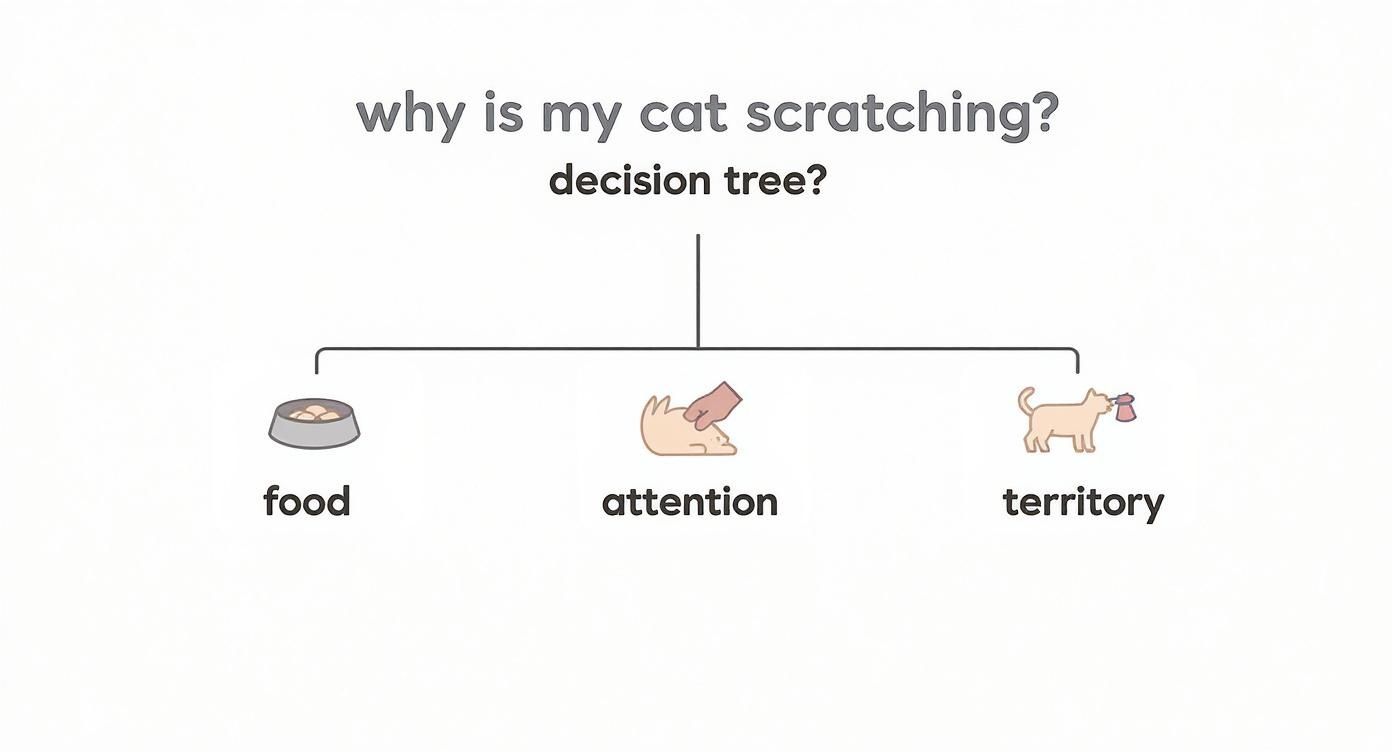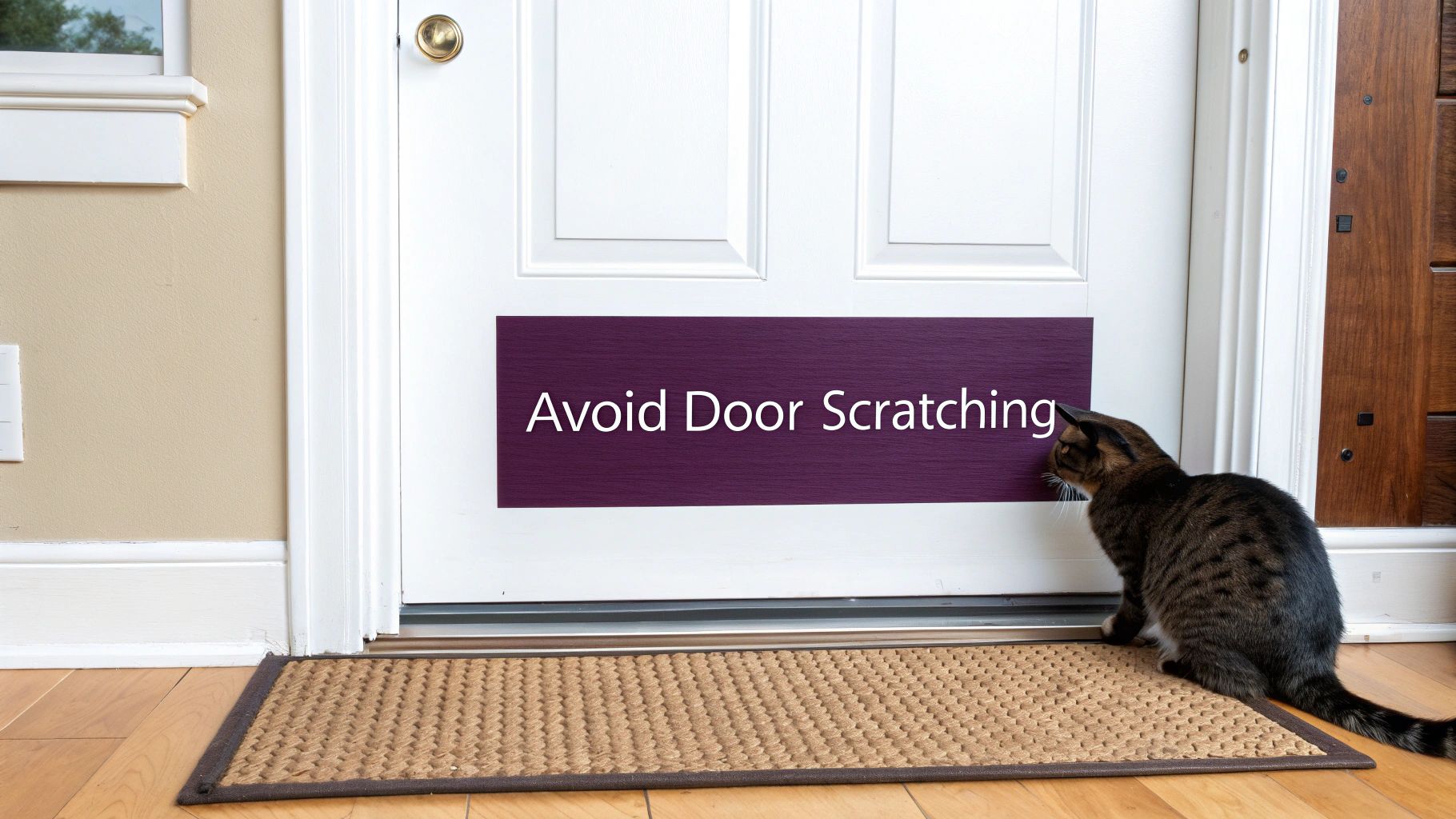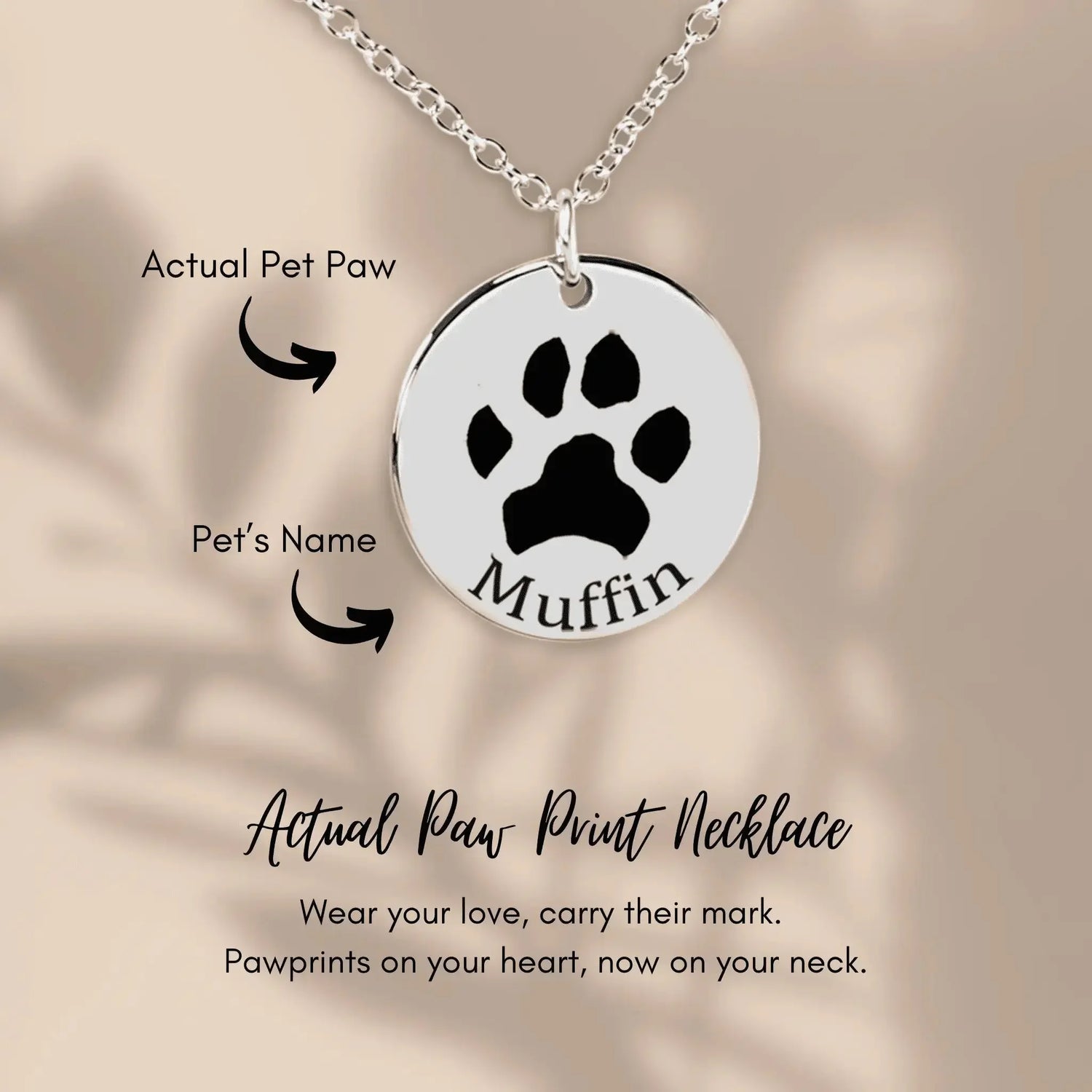How to Stop a Cat From Scratching at the Door Like a Little Gremlin 👹

So, you want to stop your cat from scratching at the door? First, you have to become a bit of a feline detective and figure out why they're doing it in the first place. This isn't just random destruction; it's a form of cat-munication! Your furball is trying to tell you something, and once we crack the code, we can find a solution for a peaceful, scratch-free home. Let's get this sorted, says our Chief Floof Officer, Floofie!
Decoding Your Cat's Door Scratching Habit
If the thump-scratch-scratch on your bedroom door is your unofficial 5 AM alarm clock, you're definitely not alone. Our mascot, Floofie, totally gets it. 😼 Before we can fix the problem, we need to speak fluent cat and get to the bottom of what’s motivating this door demolition.
That insistent scratching is a message, plain and simple. Your furry overlord has something important to say, and it’s our job to translate.
The Most Common Reasons for Door Scratching
Every cat is a little different, but most door-scratching shenanigans boil down to a handful of key motivations. Pinpointing which one applies to your little buddy is the first real step toward reclaiming your sanity and your woodwork.
-
"Feed Me, Human!" 🥐: Lots of cats connect the person behind the closed door with their next meal. If the scratching gets frantic around breakfast or dinner time, they’ve likely trained you to open up and serve their food on command. They're not just hungry; they're enforcing a routine they've worked hard to perfect.
-
Territorial Instincts: Cats are the undisputed rulers of their domain. A closed door is just an infuriating barrier keeping them from patrolling their entire kingdom. They scratch to leave their scent from the glands in their paws, basically putting up a little sign that says, "Floofie was here, and this is MY hallway."
-
Attention Seeking & Loneliness: Sometimes, the simplest answer is the right one: your cat just misses you! They've learned that making a racket at the door almost guarantees you'll appear. Even grumpy, sleepy attention (like a muffled "stop it!") is still attention in their book. This is especially common for cats who get a little anxious when they're left alone.
Floofie's Fun Fact: A cat’s meow is a behavior they developed almost exclusively to communicate with humans! If your cat is scratching and vocalizing, they are definitely trying to get a message across. For more on this, check out our guide on why your cat might be yelling at you.
Understanding the "why" behind the scratch is everything. A cat clawing for food needs a completely different approach than one scratching out of boredom or anxiety. Once you’ve figured out their secret code, you can start using strategies that actually work.
Building a Scratch-Approved Environment
Alright, so you’ve put on your detective hat and figured out why your cat is auditioning for a home renovation show on your door. Now for the fun part: giving them something way more satisfying to shred. It's time to turn your home into a feline paradise where doors are boring and scratching posts are the main event. 😻
The secret is all about strategic diversion. Think of it as offering a five-star meal when they were about to settle for scraps. If your cat has an amazing, sturdy, and perfectly placed scratching post, that boring old door won't even get a second glance.

This little decision tree is a great visual for figuring out the "why" behind the scratch. Whether it's hunger, boredom, or a cry for attention, there's always a reason. The quickest fix is almost always providing a better, more appropriate outlet for that natural instinct.
Choosing the Purrfect Scratching Posts
In the discerning eyes of a cat, not all scratchers are created equal. A wobbly, short post is about as appealing as a surprise bath. Your cat craves something that lets them get a full, glorious stretch while feeling totally secure, like our awesome cat tree!
- Go Tall and Sturdy: A solid scratching post needs to be tall enough for a full-body, vertical stretch. Just as important is a heavy base that won't wobble or tip over. Nobody likes an unstable workout machine!
- Terrific Textures: Sisal rope is the gold standard for most cats—it shreds beautifully and feels a lot like tree bark. But don't forget that some cats are individuals with unique tastes, preferring corrugated cardboard, sturdy carpet, or even natural wood.
- Variety is Key: Offer a few different types to see what your kitty prefers. Think vertical posts for those big stretches, horizontal pads for a lounge-and-scratch session, and angled scratchers for a different kind of workout.
A great scratching post is an investment in your cat's well-being (and your door's survival!). Here's a quick comparison to help you find the best scratching materials and styles for your cat's needs.
Choosing the Purrfect Scratching Post
| Scratcher Type | Best For | Floofie's Pro-Tip |
|---|---|---|
| Sisal Rope Post | Most cats; satisfies the urge for a deep, shredding stretch. | The gold standard. Get one that’s at least 30 inches tall so they can fully extend. |
| Cardboard Lounger | Cats who love scratching horizontally and lounging in the same spot. | These are great (and often affordable!) but need replacing more frequently. |
| Carpet-Covered Post | Cats who already target carpets or rugs. | Be cautious with these—they can sometimes blur the lines between "yes" and "no" surfaces. |
| Wood or Bark Post | Adventurous cats who enjoy a more natural, tree-like texture. | Perfect for bringing a bit of the outdoors in. Ensure the wood is pet-safe. |
Ultimately, having a few options ensures your cat will always have an approved spot to let their claws out, no matter their mood.
Strategic Scratcher Placement
Where you put the scratcher is just as important as which one you buy. Tucking it away in a dusty corner of the basement just won't cut it.
Here’s our top tip: place a fantastic new scratching post right next to the door they've been targeting. This move is less of a suggestion and more of a giant, flashing neon sign pointing them to the correct scratching zone. It’s all about making the right choice the easiest and most obvious one.
The more options, the better! Research clearly shows a direct link between the number of scratching surfaces in a home and a reduction in unwanted scratching. Providing plenty of approved outlets is one of the best ways to keep your doors and furniture safe.
In fact, one study of over 4,100 cat owners found that inappropriate scratching was significantly lower in homes with more scratching posts. It just goes to show that giving them plenty of "yes" zones is a powerful way to satisfy that natural instinct.
While door scratching is a unique challenge, the principles of redirection work wonders everywhere. To save your sofas and chairs, check out our complete guide on how to stop a cat from scratching furniture. It’s packed with tips that work for any surface your cat has decided to "redecorate."
Training Your Cat with Positive Reinforcement
Alright, let's get to the good stuff—teaching your cat what you actually want them to do. It’s way more effective than just trying to stop the behavior you don't like. Forget the old-school scolding or startling them with a spray bottle; we're all about those pawsitive vibes here. The whole idea is to make the right choice the most fun, rewarding option in the room.
To get your cat to stop using your door as their personal nail file, we need to show them that their scratching post is where the real party's at.

Make the Scratching Post a Five-Star Attraction
Your mission is to turn that humble scratching post into the hottest club in town. The second you see your cat even glance at it with a flicker of curiosity, be ready with praise. If they put their paws on it? Let them hear a happy, "Good kitty!"
The instant they dig those claws in and start scratching, it’s jackpot time. 🎰
- Treats on Demand: Keep a little jar of their absolute favorite, high-value treats right by the post. The moment their claws hit the sisal, toss them a treat. This forges a powerful and immediate connection: scratching this awesome post = delicious snacks.
- Verbal Praise: Use a cheerful, encouraging tone. Cats are masters at reading our emotions, and your happy voice reinforces that they’ve just done something wonderful.
- Playtime Rewards: Not all cats are food-motivated. For some, play is the ultimate prize. Try dangling one of these awesome interactive wand toys near the post to lure them over. A good scratch session could earn them a fun chase!
This isn't just about bribery; it's about building a rock-solid positive association. You’re teaching them a new, acceptable behavior that satisfies their natural scratching instinct and gets them a fantastic reward.
Floofie's Tip: Sprinkle a little catnip on the base and sides of the scratching post to make it completely irresistible. The scent will draw your cat in, and the rewards you provide will keep them coming back for more.
Why Punishment Fails and Pawsitivity Prevails
It can be so tempting to clap your hands loudly or grab a spray bottle when you hear that familiar thump-scratch-thump on the door. But honestly, these methods often do more harm than good. Your cat doesn't learn, "Oh, scratching the door is wrong." Instead, they learn that you are unpredictable and scary. 🙀
This can ramp up their anxiety, which might actually make them scratch more as a way to cope with stress. Punishment doesn't get to the root of the problem—their need to scratch—it just adds fear to the equation.
Science actually backs this up. A study found that using positive reinforcement, like rewarding a cat for using their post, was directly linked to a decrease in unwanted scratching. In contrast, punishment-based methods were associated with an increase in scratching on doors and furniture. You can read the full research about these cat behavior findings to see the data for yourself.
By making the scratching post a place of treats, praise, and fun, you empower your cat to make the right choice on their own. They'll start to see their post as a source of joy and the door as just… well, a boring old door. It's a much better way to build a stronger, more trusting bond with your best little buddy.
Making the Door an Unappealing Scratch Zone
While you're working on making the scratching post the hottest spot in the house, it's time to play a little defense. The mission? Make the door a totally uncool, boring, and unappealing place to get those claws into. We’re talking about gentle nudges, not punishments, designed to redirect your cat’s attention to much better, shreddable options.
Think of it from your cat's point of view: if one surface feels weird and sticky but another feels like a glorious, satisfying tree trunk, the choice is pretty obvious. We're just making that choice crystal clear.

Textures That Say "Paws Off"
Cats are incredibly particular about what they sink their claws into. A door’s smooth, sturdy surface is often a prime target, but we can change that texture to make it feel less-than-purrfect under their paws.
-
Double-Sided Sticky Tape: Most cats absolutely despise sticky sensations on their paw pads. Applying some pet-safe, double-sided sticky tape strips to the most-scratched areas of the door is a classic, effective trick. One touch of that tacky surface, and they’ll likely recoil and rethink their life choices.
-
Vinyl Door Shields: For the most determined scratchers, a clear plastic door shield is a total lifesaver. These create a slick, impenetrable barrier that offers zero satisfaction for scratching claws. They'll get the message loud and clear: "this spot is officially busted."
-
Textured Mats: Sometimes, just changing the floor in front of the door is enough. Placing a textured runner or even a sisal doormat right where they stand to scratch can work wonders. If the approach feels weird or prickly, they might not even bother.
Remember, the goal isn't to scare your cat away from the door forever. It's simply to make the act of scratching that specific surface unpleasant, encouraging them to seek out the awesome scratching post you’ve provided nearby.
Scents That Cats Can’t Stand
A cat's sense of smell is a superpower, and we can use it to our advantage. Certain smells that we find pleasant or neutral are a major turn-off for most felines.
A light spritz of a citrus-scented spray around the bottom of the door can make the whole area much less attractive. Cats generally find the smell of oranges, lemons, and grapefruit to be overpowering. Just be sure you're using a product that's specifically made to be safe for pets and won't damage your door’s finish.
For more ideas on protecting your woodwork, this guide to protecting wood furniture from scratches has some great tips that can easily be adapted for doors. Combining these deterrents with the positive training we've discussed creates a powerful one-two punch to stop door scratching for good.
Enriching Your Cat's Daily Life
If that non-stop door scratching seems to kick into high gear whenever you're busy or out of the room, you probably have a bored kitty on your hands. A cat without enough to do is like a furry little chaos engine searching for a target—and your door is it. Our mascot, Floofie, is a firm believer that a tired cat is a happy cat, and a happy cat is way too busy napping to redecorate your woodwork. 😼
This is all about enriching your cat's world to channel that energy into something positive, not destructive. A happy, engaged cat simply doesn't have the time or the inclination to worry about what’s happening behind a closed door. It's time to build a kitty paradise!
https://www.youtube.com/embed/Y8oyZmrvdQE
The Magic of Routine and Play
Cats are creatures of habit. They absolutely thrive on predictability. Having a consistent daily routine helps them feel secure, which dials down the anxiety that often fuels behaviors like door scratching. This doesn't need to be complicated—we're talking scheduled feeding times and, most importantly, dedicated playtime.
Whipping out an interactive feather wand for 15 minutes twice a day can make a world of difference. A good, heart-pumping session that lets them mimic the full hunt cycle—stalk, chase, pounce, and "kill"—taps into their primal instincts and leaves them ready for a nice, long nap.
Floofie's Tip: Always end your play sessions by letting your cat "catch" their prey. This gives them a satisfying end to the hunt and prevents frustration. Just let them have the toy for a minute before you put it safely away.
Puzzle Feeders and Interactive Toys
A bowl of food is fine, but making your cat work for their meal is even better! It engages their brain and makes them feel like the clever little hunter they were born to be.
- Puzzle Feeders: These brilliant toys require your cat to bat, nudge, or figure out a simple puzzle to get their kibble. It turns a five-second scarf-down into a 10-minute mental workout.
- Automated Laser Toys: For times when you're busy, an automated laser can provide some fun. Just be sure to follow it up with a physical toy they can actually catch to avoid any frustration!
- "Cat TV": A well-placed bird feeder just outside a window can provide hours of free entertainment. For the ultimate viewing experience, pair it with a comfy cat tree right by the window.
Creating a stimulating environment is one of the best ways to keep your cat happily occupied. For more ideas, check out our deep dive into how to entertain indoor cats and turn your home into a feline funhouse.
Creating a Calm and Secure Territory
Sometimes, the scratching isn't about boredom—it's anxiety. A calm environment is key to helping your cat feel safe and secure. Something as simple as a tall cat tree gives them a safe spot to survey their kingdom from up high, which is a huge confidence booster for cats.
For kitties prone to stress, a calming pheromone diffuser can work wonders. These release "happy messages" into the air, creating a more tranquil home vibe.
Beyond preventing unwanted behaviors, a healthy living environment is key. You might want to explore resources on general carpet cleaning for pet owners to keep your home fresh and comfortable for everyone. By enriching their lives, you'll help stop your cat from scratching at the door because they'll be too busy ruling their awesome, fun-filled kingdom.
When It’s Time to Call in the Pros
So, you’ve turned your home into a feline paradise. You’ve set up some truly magnificent scratching posts, mastered the art of doling out tasty treats for good behavior, and made your door about as appealing as a surprise bath… but the scratching just won’t stop. First off, take a deep breath. You're doing a great job. 💖 Changing a deep-rooted habit takes time and a ton of patience!
But sometimes, even with our very best efforts, a cat's door-scratching can be a real head-scratcher. Every cat is their own quirky little weirdo, and some puzzles are just too tricky to solve on our own. If you feel like you've tried everything and are still getting a rude awakening from those persistent claws, it might be time to call in the experts. Floofie approves of asking for help!
Stubborn Cases and Specific Triggers
Some situations just make scratching habits particularly tough to break. Does your cat only start shredding the door when you have guests over? Or maybe the behavior kicked off right after you moved to a new home. Scenarios like these often point to deeper issues like stress, territorial insecurity, or anxiety that need a more specialized approach.
It's also super important to consider if this is a sudden change. If your normally chill cat abruptly starts scratching at doors with a frantic energy you've never seen before, it could be their only way of telling you something is wrong.
Getting expert help isn’t a sign of failure. It's a sign that you’re an amazing pet parent who’s committed to giving your cat the absolute best care possible. Think of it as adding a specialist to your cat's wellness team!
When to Call the Veterinarian
Before you jump to the conclusion that this is purely a behavioral problem, a trip to the vet is a must. This is especially true if the door scratching is a new or escalating behavior. There are a handful of medical reasons that could be causing your cat distress, which then leads them to act out.
Your vet can check for and rule out common culprits like:
- Hyperthyroidism: This condition can ramp up a cat's activity levels and anxiety.
- Pain or Discomfort: An underlying injury or illness might be making them restless and unable to settle down.
- Cognitive Issues: In older cats, confusion can lead to all sorts of new and unusual behaviors.
Getting a clean bill of health lets you focus entirely on the behavioral side of things, knowing you aren't missing a hidden medical problem.
Consulting a Cat Behaviorist
If the vet gives your kitty the all-clear, your next call should be to a certified cat behaviorist or animal behavior consultant. These professionals are the cat whisperers of the world! 🐾 They have a knack for identifying complex triggers and can create a personalized plan to stop your cat from scratching at the door for good. They’ll take a deep dive into your home environment, your cat's history, and your daily routines to get right to the root of the problem.
Don't give up! With a little extra help, you can absolutely restore peace to your home and make the bond with your furry best friend even stronger.
At FloofChonk, we believe every cat deserves to be happy, healthy, and understood. While you work on creating a peaceful home, explore our collection of toys, apparel, and decor designed for people who are truly passionate about cats. Find the purrfect gift for your favorite feline fanatic at https://www.floofchonk.com.

